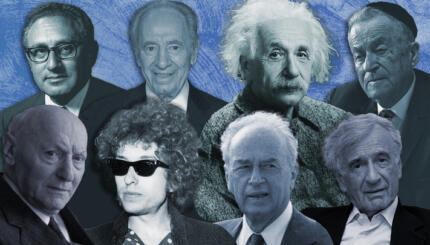Over several days in late August 1991, the Brooklyn, New York, neighborhood of Crown Heights pulsated with sporadic street violence, as predominantly black protesters targeted members and institutions of the Lubavitch Jewish community.
Though the Crown Heights Riots were concentrated in a small subsection of the inner-city neighborhood that had long been known for its well-heeled brownstones and eclectic ethnic makeup, the three days of strife in 1991 spurred changes that far outstretched their immediate effects.
The Car Accident
Around 8:00 PM on Monday, August 19, 1991, Menachem Mendel Schneerson, the international leader and Rebbe of the Chabad Lubavitch movement was returning to his home in Crown Heights, Brooklyn after a visit to the Old Montefiore Cemetery in adjacent Queens
Each time the Rebbe made this trip–his only excursion out of Crown Heights–he was provided a police escort. With the New York Police Department squad car in the lead, the Rebbe riding in the second car, and a station wagon following close behind, the three-vehicle procession advanced west on President Street. Though meant to be a tightly coordinated caravan, the rear station wagon, driven by 22-year-old Yosef Lifsch, briefly lost the group. Lifsch tried to close this gap as he approached the intersection of President Street and Utica Avenue.
With your help, My Jewish Learning can provide endless opportunities for learning, connection and discovery.

What happened next remains disputed through today. Whether Lifsch ran through a red light or did not slow at a yellow, his car contacted another that was traveling on Utica Avenue. As Lifsch lost command of his car, the momentum of the impact carried his station wagon into a wall, and then slid it along until it came to rest on the body of seven-year-old Gavin Cato. The son of Guyanese immigrants, Cato had been playing with his cousin on the sidewalk. He was instantly killed.
First on the scene was Hatzolah, a Lubavitch-funded private ambulance service, quickly followed by the police. Passersby gathered, forming a group that soon numbered in the hundreds. Concerned for the safety of Lifsch and his passengers, the police directed Hatzolah to take them–and not Cato or his cousin–to the hospital. Instead of easing the situation, it inflamed the crowd, who suspected preferential treatment.
If some had read intent into Lifsch’s automobile accident, the favoritism the police appeared to be showing the Lubavitch passengers was seen as yet another example of the privilege the Jewish minority enjoyed at the expense of the black majority in Crown Heights. While the Lubavitchers represented only 11% of Crown Heights’ citizenry, they were widely thought to wield great influence with the police and city government.
Ensuing Violence
Anger turned to violence. Charles Price, a 37-year-old area resident who had come to the scene of the accident, harangued the masses with claims that, “The Jews get everything they want. They’re killing our children.” Another male implored the group to, “go to Kingston Avenue [a major thoroughfare in the Jewish section of Crown Heights] and get the Jews,” The group made good on its promise.
Approximately three hours after Lifsch lost control of his car, Yankel Rosenbaum–a 29-year-old Jewish student from Australia–was killed by a group consisting mostly of neighborhood youth, in what would be interpreted as a retaliatory slaying. And in the few hours following the accident, a Yeshiva van was set on fire, neighborhood youth threw bottles at Jews and Jewish institutions, and one fired a gun at a police officer.
For the next three days and four nights, sporadic rioting rocked Crown Heights. While not the exclusive province of black youth, the assaults, intimidation, and destruction were mostly perpetrated against Crown Heights’ Lubavitch community, and mostly at the hands of young rioters
A summary of the three days reads like a laundry list of violence: On August 20, approximately 500 mostly young blacks returned to the scene of Lifsch’s accident. Vehicles were set ablaze, a shoe store was ransacked, and reporters and photographers were beaten. The next day, hundreds of marchers gathered at 770 Eastern Parkway–Chabad-Lubavitch World Headquarters. An Israeli flag was burned. Lubavitchers took to the streets in response. Groups of blacks and Jews assailed each other with bottles. On Thursday, August 22, the tenor began to change, gradually, as the NYPD shifted its tactics.
Some blatantly anti-Semitic rhetoric was expounded by some community leaders who headed non-violent marches and protests parallel to the street violence. Speaking of the accident at Cato’s funeral, Al Sharpton famously said “The world will tell us that he (Cato) was killed by accident. Yes, it was a social accident?It’s an accident to allow an apartheid ambulance service in the middle of Crown Heights.”
Suggesting Jewish community responsibility for the death of Cato–and condoning the violence that was then ravaging the streets–some of the rioters proudly alluded to the anti-Semitism of Nazi Germany: a banner was seen at Cato’s funeral stating, “Hitler did not finish his job.”
Aftermath & Lasting Effects
In the aftermath of the Crown Heights Riots, New York State governor Mario Cuomo and the state’s director of criminal justice, Richard Girgenti, ordered an official investigation. The Girgenti Report, as it became known, was strongly critical of the New York City Police Department–which he called “uncoordinated and ineffective”–and its commissioner, Lee Brown.
Initially, the Department had practiced a strategy of containment in response to mounting violence in the streets, directing its officers only to stop the spread of disorder, but not to try to dispel it. While the report cleared New York City Mayor David Dinkens of deliberately hamstringing his officers, Brown was faulted for being aloof.

Meanwhile, anecdotal evidence from the statements of individual patrolmen suggests that some officers were prohibited from aggressively countering the violence they met on the streets. Many Lubavitchers were disappointed to find they could not get adequate protection from the police department during the riot.
The hands-off approach that the police first took gelled with Mayor Dinkens’ political persona. He was elected in 1989 on a peacemaking platform–in contrast to his opponent Rudolph Giuliani, who took a more conservative “law and order” line. Indeed, even during the riots, Dinkens tried to calm both sides with rhetoric of unity, at one point telling a crowd of protestors, “Increase the peace,” and “I care about you–I care about you very desperately.”
In the 1993 mayoral race, Dinkens would pay for the failure of his benign approach. A significant contingent of Jews who had supported him in 1989 decamped for the Giuliani ticket, and this contributed to Dinkens’ loss.
The most unexpected consequence? Healing and cooperation in Crown Heights. While relations between the Lubavitch community and its Crown Heights neighbors have certainly not been placid since 1991, some notable developments, including the creation of a mediation center in 1998, have heralded a developing coexistence.


